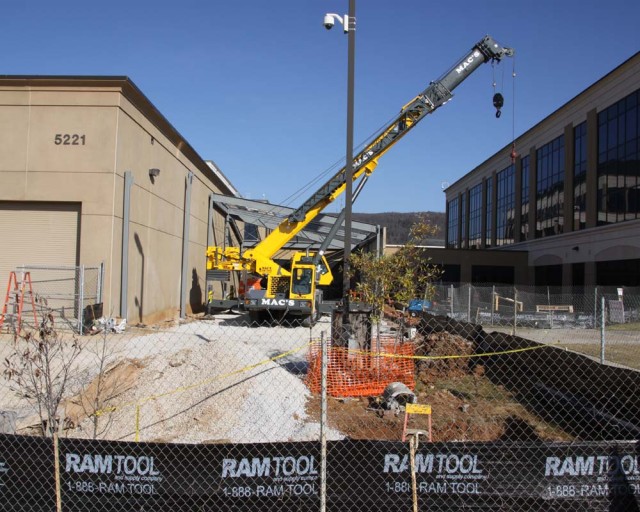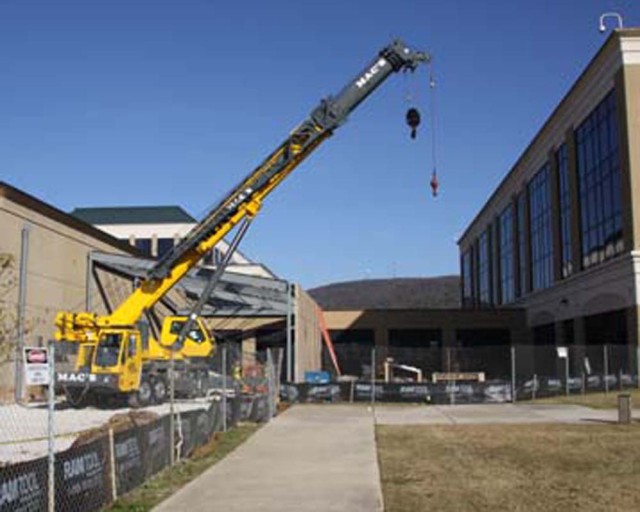REDSTONE ARSENAL, Ala. - Construction is underway on the 3,800 sq. ft. expanded Concepts Analysis Lab at USASMDC/ARSTRAT. The new lab will feature an open and collaborative office environment for training the future workforce in space and missile defense research and development.
The lab's mission includes developing and evaluating new technical concepts and recruiting, training and mentoring students and young professionals in the technical field of space and missile defense.
"The Concepts Analysis Lab was established as a way to address the need for new innovative technology concepts to support the Warfighter," said Dr. Rodney Robertson, Technical Center Director. Dr. Robertson envisions the lab as a way to develop new technology concepts and train young engineers and scientists in the workforce. "The lab has been so successful with its engineering development and student training that it has outgrown the facilities that we currently have in place.
"The new lab will house 30 workstations, three large collaboration tables, and a classroom area with 12 student/operator consoles," said Pete Kirkland, technical advisor to Dr. Robertson. "The operator consoles will face four big-screen monitors for training, mission control and simulated operations."
The Concepts Analysis Lab was formed in 2004 at the direction of Mr. Jess Granone, the previous Technical Center Director. Since then, the Concepts Analysis Lab has trained young students and professionals on radar concept programs, the use of missile defense algorithms for breast cancer research, and will soon add satellite tracking stations and a clean room for nanosatellite assembly and payload development.
"One radar system students are working on is the Force Encampment Protection System (FEPS) radar which is designed to protect troops from rocket and mortar attack," Kirkland said. "Another next-generation radar program students work on is all digital radar. This new radar technology is digitized and flexible so it can be built directly into the skin of things like unmanned aerial vehicles or even body armor," he said. "It's very different from the rigid antenna radars that are more commonly used."
Student employees at the lab are also actively engaged in blending medical technology research with missile defense applications.
"Students are currently working with algorithms that are developed as a means to detect, discriminate, and classify targets in clutter. It turns out that these algorithms are very useful for the similar problems of detecting cancer in a mammogram image as well as detecting lethal objects in ballistic missile threat cloud," said Kirkland. "Our students work with these algorithms to detect and discriminate breast cancer and are developing algorithms to predict the probability of breast cancer from clinical data," he said.
In addition to the expanded lab, a newly constructed satellite tracking station and clean room for nanosatellite assembly and payload development was recently completed and will soon be operational.
"The satellite tracking station will house three to four workstations that have direct communication links to satellites from antennas we have placed on the building," said Mark Ray, general engineer and former student in the Concepts Analysis Lab. "Students will perform missions including tracking, monitoring and tasking the satellites."
"The clean room for nanosatellite assembly and payload development will allow three to four student employees at a time to work in a clean room as they work with nanosatellite technology," Ray said. "We will soon have the capability to train these young student employees in an atmosphere that allows for hands-on development of technology and have the ability to demonstrate and transition technology to acquisition, all within our organization," Ray said.
The students working in the Concepts Analysis Lab were hired on at USASMDC/ARSTRAT through a variety of student recruitment and development programs.
"Our students work and attend school full-time," said Kevin Nash, lab supervisor and co-founder with Kirkland. "We have young employees in the Students Working for the Army in Parallel (SWAP) program that were hired as contractors through the University of Alabama Huntsville. They work 16-20 hours a week in between classes," he said.
"We have the Student Temporary Employment Program (STEP), in which students are hired as U.S. Government employees during the summer, and can work 16-20 hours a week while attending school. We also have students in the Cooperative Education program, who work one semester and go to school alternate semesters until they graduate."
In addition to these student recruitment avenues, Kirkland mentioned another valuable program available to students via the Department of Defense Science, Mathematics and Research for Transformation (SMART) Scholarship for Service program.
"The U.S. Government awarded USASMDC/ARSTRAT $1 million in scholarship and stipend funding for nine students as part of the DoD SMART Scholarship for Service program. These students currently receive a stipend for tuition and must agree to work for the U.S. Government upon graduation equal to the number of years the government pays for their education bills," said Kirkland. "They work in the summer, and although SMART students owe a commitment to work for the U.S. government upon graduation, they have the unique opportunity to train and work in a highly technical field."
Construction on the addition to the new Concepts Analysis Lab is expected to be completed in April 2010 and the Satellite Tracking Station and clean room are expected to be operational in January 2010.
Deborah.erhart@us.army.mil




Social Sharing